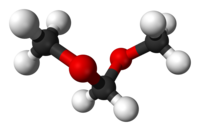Dimethoxymethane
 |
|
 |
|
| Names | |
|---|---|
|
IUPAC name
Dimethoxymethane
|
|
| Other names
Formal
Formaldehyde dimethyl ether |
|
| Identifiers | |
|
3D model (Jmol)
|
|
| 1697025 | |
| ChEBI | |
| ChemSpider | |
| ECHA InfoCard | 100.003.378 |
| EC Number | 203-714-2 |
| 100776 | |
| MeSH | Dimethoxymethane |
|
PubChem CID
|
|
| RTECS number | PA8750000 |
| UN number | 1234 |
|
|
|
|
| Properties | |
| C3H8O2 | |
| Molar mass | 76.10 g·mol−1 |
| Appearance | Colorless liquid |
| Odor | Chloroform-like |
| Density | 0.8593 g cm−3 (at 20 °C) |
| Melting point | −105 °C (−157 °F; 168 K) |
| Boiling point | 42 °C (108 °F; 315 K) |
| 33% (20 °C) | |
| Vapor pressure | 330 mmHg (20 °C) |
| -47.3·10−6 cm3/mol | |
| Hazards | |
|
EU classification (DSD)
|
Flammable (F) Irritant (Xi) |
| R-phrases | R11 R36/37/38 |
| S-phrases | S9, S16, S33 |
| Flash point | −18 °C (0 °F; 255 K) |
| Explosive limits | 2.2%-13.8% |
| Lethal dose or concentration (LD, LC): | |
|
LD50 (median dose)
|
5708 mg/kg (rabbit, oral) |
|
LC50 (median concentration)
|
18000 ppm (mouse, 7 hr) 15000 ppm (rat) 18354 ppm (mouse, 7 hr) |
| US health exposure limits (NIOSH): | |
|
PEL (Permissible)
|
TWA 1000 ppm (3100 mg/m3) |
|
REL (Recommended)
|
TWA 1000 ppm (3100 mg/m3) |
|
IDLH (Immediate danger)
|
2200 ppm |
| Related compounds | |
|
Related Ethers
|
Dimethoxyethane |
|
Except where otherwise noted, data are given for materials in their standard state (at 25 °C [77 °F], 100 kPa).
|
|
|
|
|
| Infobox references | |
Formaldehyde dimethyl ether
Methylal
Dimethylformal (DMFL)
Formaldehyde dimethylacetal
Methoxymethyl methyl ether
Dimethoxymethane, also called methylal, is a colorless flammable liquid with a low boiling point, low viscosity and excellent dissolving power. It has a chloroform-like odor and a pungent taste. It is the dimethyl acetal of formaldehyde. Dimethoxymethane is soluble in three parts water and miscible with most common organic solvents.
It can be manufactured by oxidation of methanol or by the reaction of formaldehyde with methanol. In aqueous acid, it is hydrolyzed back to formaldehyde and methanol.
Due to the anomeric effect, dimethoxymethane has a preference toward the gauche conformation around the C–O bonds, instead of the anti conformation. Since it is one of the smallest molecules exhibiting this effect, which has great interest in carbohydrate chemistry, dimethoxymethane is often used for theoretical studies of the anomeric effect.
Industrially, it is primarily used as a solvent and in the manufacture of perfumes, resins, adhesives, paint strippers and protective coatings. Another application is as a gasoline-additive for increasing octane number.
Another useful application of dimethoxymethane is to protect alcohols with a MOM ether in organic synthesis. This can be done using phosphorus pentoxide in dry dichloromethane or chloroform. This is a preferred method to using MOM-Cl. The MOM-ether can be removed using methanol in the presence of p-toluenesulfonic acid as an alternative to aqueous acid.
...
Wikipedia
